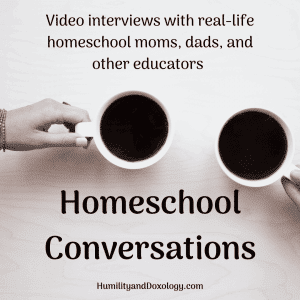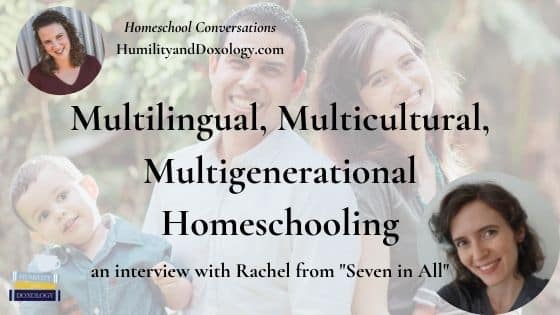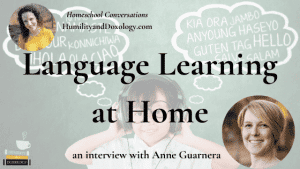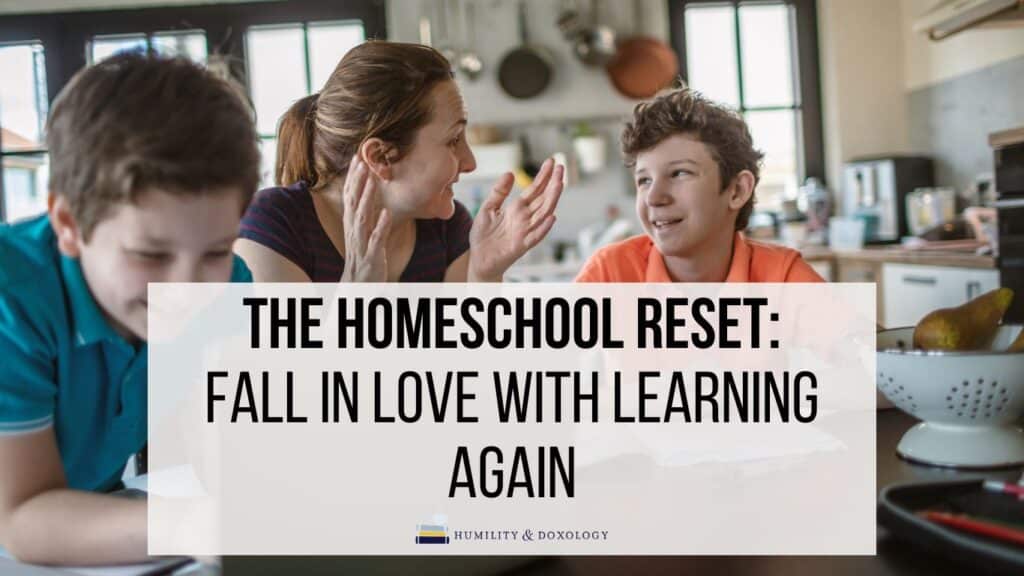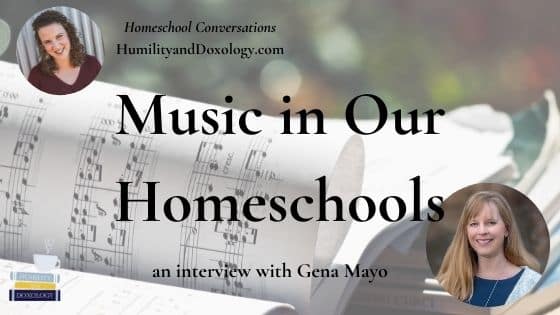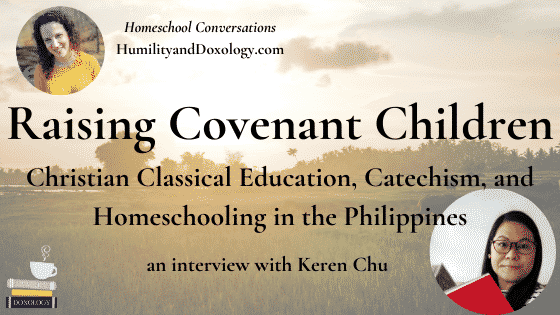Second-Generation, multilingual, multicultural homeschooling? Yes, please! Tell me more! I so enjoyed my conversation with Rachel from Seven in All (and Where’d You Learn That), and know that you will find lots of inspiration and encouragement from this chat. It’s always especially fun for me to get to know people living in other parts of the globe. Please read, listen to, or watch this week’s Homeschool Conversations interview and let me know what stands out to you!
Be sure to check out all the other interviews in our Homeschool Conversations series!
Watch the video. Listen to the podcast. Read the show notes. Share with your friends!
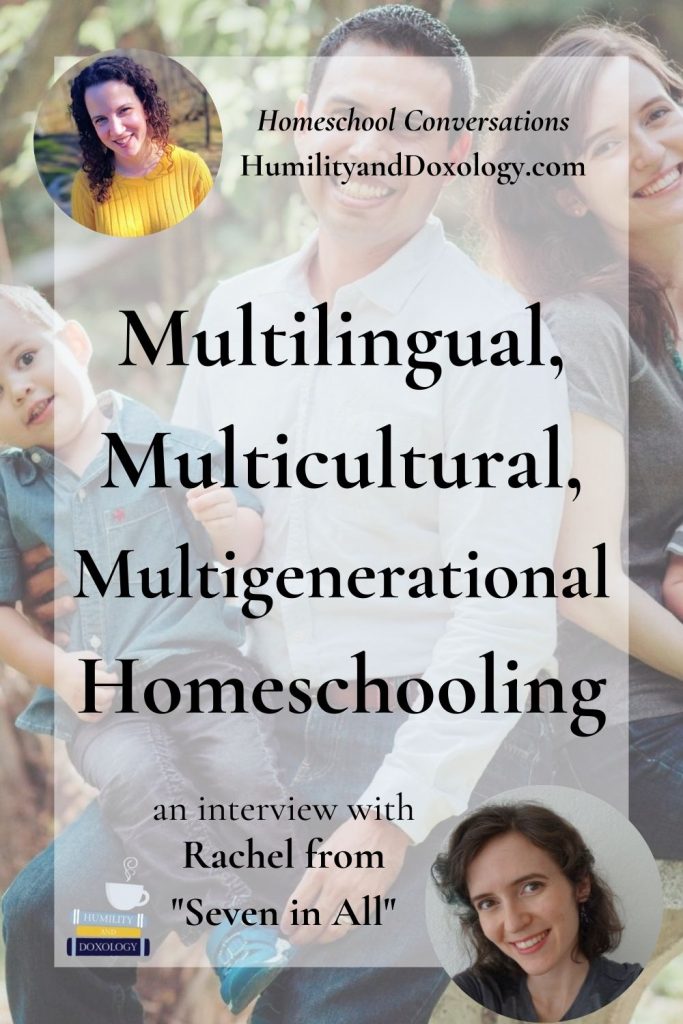
Who is Rachel from Seven in All?
Rachel was homeschooled from PreK through 12th grade, but apparently that wasn’t enough. Today, she’s a second-generation homeschooler who also runs a Youtube channel, Seven in All, where she talks about practical recommendations and resources for building a joy-filled homeschool. She’s also a homeschool curriculum writer, who, after writing content for larger curriculum companies, has launched her own site where she sells affordable homeschool resources, in multiple languages (mainly English and Spanish, with hopes of more Mandarin Chinese offerings in the future!).

Watch my interview with Rachel from Seven In All
Prefer to listen to your content? Subscribe to Homeschool Conversations on Apple podcasts or wherever you get your podcasts so you don’t miss a single episode!


Amy: Hello, everyone. Today I’m delighted to be joined by Rachel from Seven In All. Rachel was homeschooled from preschool through 12th grade, but, apparently, that wasn’t enough. Today she’s a second-generation homeschooler who also runs a YouTube channel Seven In All, where she talks about practical recommendations and resources for building a joy-filled homeschool.
She’s also a homeschool curriculum writer, who after writing content for larger curriculum companies, has launched her own site where she sells affordable homeschool resources in multiple languages, mainly English and Spanish, but with hopes of more Mandarin, Chinese offerings in the future. I’ve enjoyed watching many of your YouTube videos over the past few months and I’m excited to get to talk to you.
Rachel: Thanks.
Rachel’s Experience as a 3rd-Culture, 2nd-Generation Homeschooler
Amy: Rachel, could you tell us a little bit about your family and your own history with homeschooling?
Rachel: I am the oldest of a big family, I’m the oldest of eight kids and I was homeschooled all throughout my school experience up until high school graduation. Back in the days, I’m sure you are also familiar with homeschooling in the ’90s, back before you had all these convenient internet things and new modern resources. Homeschool has always been a part of my life in that sense. Then now I have two young sons of my own.
About six years ago, after college, I moved back to be close to my family. Just to be closer to them and spend more time with my youngest sisters as they grow up. I helped my mom with homeschooling, and take on some of the classes in my specialty subjects. It’s been really fun to be involved in homeschool on the other side and now beginning to homeschool my own sons.
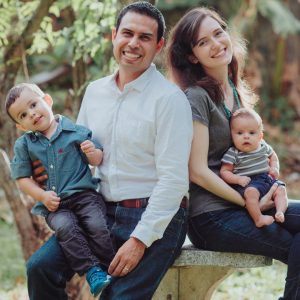
Amy: What a delight too, especially when you have a big age range to be able to have that special time with your younger siblings.
Rachel: Yes, I wouldn’t have had the chance to get to know them this way if we hadn’t come back. Now, I love getting to do life with them and see them almost every day. [chuckles]
Amy: That’s amazing. Did you always plan to homeschool your children?
Rachel: It was definitely always on the radar. You grow up homeschooled, you get a little bit spoiled with the flexibility of pacing and doing school on your own time and all that. I enjoyed my college experience too as well. I love learning just in general. Homeschool was always definitely an option on the radar, but I don’t think it became a reality until I had kids.
When I didn’t have kids yet, then it was more of just a theory, but now that I actually have kids, and I’ve been spending more time thinking about it even also talking about homeschool on YouTube. It’s really solidified for me how much I do believe in this, how much I love the homeschool lifestyle, and that’s the kind of childhood I want for my kids. It took having kids to make it real, but, yes, I want to do this.
Amy: I think as a second-generation homeschooler myself, that freedom and flexibility, also that not having to fit in anyone’s box or do things, even though other homeschoolers do them, I don’t think I could ever give that up.
Rachel: It would be really hard to do the set schedule, living by someone else’s schedule. We do get spoiled in some sense.
Homeschooling Bilingually
Amy: Yes, in the best way possible. One of the things that I have seen you talk about is homeschooling bilingually. That’s something that you guys do in your home and in your family. I would love to hear what are some of the best parts of homeschooling bilingually and what are some of the challenges that come with that?
Rachel: My husband and I decided that we were going to raise our kids bilingual. He is Mexican by his heritage and he is a first language Spanish speaker. He learned English from going to school and went to school on English his whole life. Although we don’t live in a place where any Spanish is spoken, we wanted our kids to have this connection to this language, so that’s really important to him. We decided we’re going to raise our kids speaking Spanish and English even though we don’t have a community for that here.
We realized you can’t spend all of your time doing school, all of your time reading stories, doing learning songs in English, then spend perhaps squeeze Spanish into small amounts of time when you’re not doing school, and when you’re not with the community because the community doesn’t speak Spanish. We knew we have to make this a top priority to fit in. We’re just in the preschool stage right now. It’s going to change and I’m learning a lot as we go. Right now, we’re trying to do as much schoolwork as we can, actually, in Spanish.
Together with my husband (my husband did the translation for me) I wrote preschool lesson plans in Spanish, because I’m not a native speaker, I’m not even a really fluent speaker. If I have a plan I can work with it and I can keep going, I can keep narrating the activity from a basic plan. That’s then how I’ve challenged myself to up my game a little bit not leading the typical lyrical games in English, or not just turning to English preschool songs, not turning to English preschool books all the time. We have really tried to be very intentional with reading Spanish stories, Spanish songs, just shoving it in as much as possible.
The challenge is definitely that I’m not fluent, but I have learned a lot more and have been way more motivated since my kids were born. The other challenge is that it’s not so easy for us to access Spanish materials here, just because there is no Spanish community. I look forward to visiting the USA some time and I’m going to be bringing back suitcases full of Spanish books and stuff. I’ve already got it planned.
Amy: Nothing like book-buying for joy and fun.
Rachel: Oh, yes.
Amy: By the time this episode goes live, another episode that I recorded with Anne Guarnera is going to have been published. She also does a lot of work with bilingual homeschooling. What I heard from her, and what I’m hearing from you as well, is there’s encouragement for those of us who are not fluent in another language, that that does not mean that we can’t encourage bilingual education in our own children. There are these ways of using resources, like the resources that you have made that can guide you along the way. You don’t have to think, “Well, I just know my native language. I guess that’s it for me.” We can still include that with our children.
Rachel: Absolutely, yes. You don’t have to feel that we need experts to teach chemistry to our kids. We don’t need to be fluent language speakers in order to teach that language. I definitely have a lot of help and a lot of motivation from my husband, but because he works full-time, he’s not here all the time and I knew they needed another strong Spanish influence in their life. I’m okay, that’s going to be me, I need to learn. I’m going to use tools and resources that can help me do it. If the kids can learn it, we can learn it too.
Amy: Yes. How much of homeschooling is learning alongside our children?
Rachel: Absolutely.
Homeschooling Overseas
Amy: How does homeschooling overseas affect the way you think about what’s most important in your homeschool?
Rachel: My family has been homeschooling overseas for 17 years at this point. It’s almost hard to say what makes us feel different because it just feels normal now. Looking back, I think homeschooling overseas was what first really sparked my passion for languages and for learning multiple languages. I’m from Michigan, when I was a little kid, it just seemed normal to only speak English. That’s what is normal, that’s what was normal. Then when I first moved overseas as a young teen, suddenly, all my friends speak three languages and that’s just normal.
It totally changes your whole perspective on what’s normal as far as language ability and not that oh, it’s only for super-smart people. It can be just normal if we choose to live that way and have multiple languages. It’s not that you have to be totally fluent in every language or able to converse on every topic, but you can actually get a long way when you make it a priority. I think that’s been the biggest kind of thing that’s sparked from moving overseas was really a passion for language learning.
Amy: When I had the opportunity to travel as a teenager and had that same experience where I realized, “Wow, I have never felt so American.” [laugh] I just know English. You have people who are speaking to me in my native language and apologizing for it, not speaking English very well, and I’m always like, “Seeing as how I can’t speak your language at all, I really appreciate it.”
Rachel: I’m really impressed.
Amy: Yes, you’re doing amazing.
How can we encourage a love of other cultures or languages in our homeschool?
For those of us who are not homeschooling in our non-native cultures, how can we still encourage that love of other cultures, of other languages in our home?
Rachel: People always ask that. You can always, for sure, read books, you can always watch movies and do some of those basics when you don’t have a lot of access to other cultures. I would definitely encourage any family to as much as possible, try to make real-life people connections, because nothing replaces relationship, nothing replaces the interpersonal connection.
This is totally just my joke as being in an interracial marriage, but I say interracial marriage will solve a lot of race issues in this world.
Because suddenly two families from two very different cultures are now connected, and now they have people that they love from a very different culture. People that they love that speak a different language. Now, suddenly it’s not the other, it’s we love these people. These are our people. When you can get lots of personal connections, it is a real help. Trying to pursue, not having all your friends believe exactly the same things you believe, look the way you do, speak the same languages you do, have the same values.
Life is definitely enriched when we embrace variety.
When we teach our kids, it’s like we can find friendships and people that we do have something in common. We have something in common that we can connect with and talk about, but we have also a lot that’s not in common. In general, I would say to assess yourself or ask, how’s it going as far as your appreciation of other cultures.
I would ask when you talk about things on the other side of the world, or when you have some reaction to the other side of the world, does it seem like the other side of the world is very far away or does it seem like it’s pretty close at hand?
Just when you hear about in a news story, or you come across something in a book, or you eat sushi or whatever it is. Does the other side of the world seem very far and very disconnected from thread of connection that you can– “Oh, I care about this because I know this person because of this situation,” or something.
Because the way we choose to live can make the other side of the world seem far, or it can make the other side of the world, wherever the other side is, we can make it seem close through our connections.
Amy: That is such a good encouragement and reminder, and I love your emphasis on relationship with real people, because sometimes we can depersonalize these ideas and forget that we’re talking about real human beings–
Rachel: Real people.
Amy: These are real people. To have that focus on relationship and these other ideas are going to come, naturally flow from that.
Rachel: Yes.

Homeschool Must-Dos
Amy: Well, Rachel, when you think about your big picture goals as a family, as a homeschooling mamma. What would you say are some of your family’s essential must-dos? I know this could play into you have two little ones of your own, but you’re also involved in homeschooling older children as well. From either side or both sides, however you want to approach that.
Rachel: I think for me, one of the really big essential values is the togetherness or the team player factor in our family, which we might be a little bit extreme. I moved back to my hometown after college to help homeschool my siblings for the past six years, but we really have a strong value on we play together, we also work together. When we look for volunteer opportunities, we don’t try to choose volunteer opportunities that have dad going off to this opportunity and mom going off here, and then the kids volunteering here. We try to do things where everybody in the family can be volunteering in the same place, in the same service, just in their own abilities and in their own ways.
For our family, I’ve definitely seen togetherness. The team factor is a big core, both for the family I grew up in and also for the way my husband and I choose to live, but we don’t want to be going and being pulled in a lot of different directions. Whatever we do, we want to do it pretty much together as a family,
Amy: Even as homeschoolers, we can still find ways to still be scattered and separate. Not that there aren’t good and appropriate times to do things on our own, but when we lose that focus on that togetherness, we miss out on one of the best parts of homeschooling.
Rachel: There’s definitely times for doing things on your own and stuff. I find especially in today’s busy world, it’s all too easy to end up getting scheduled and pulled into so many different directions and being like ships passing in the night, even just with how many great things there are to do. We do try to be pretty intentional about choosing things that can fit the whole family for the most part. Everyone is going to have some specialty things, but making that togetherness a priority matters for us.
Advice for the new homeschool mom
Amy: Well, if you were talking to a new homeschool mom, what advice would you give her?
Rachel: Probably around the first thing I’d say is, chill out a little bit. Whatever you are probably most worried about, is probably not what you really need to worry about. Then the things that are going to up being hard are probably not even the things you’re thinking about right now.
From my experience of homeschool, from what I’ve seen with other homeschool families, people worry a lot about the academics. I think overall the academics usually work out okay, but some of the real issues that can steal joy are behavioral issues and relationship issues, breakdowns in the relationship and behavior.
Which that’s not even a homeschool specific problem, that’s a parenting problem, that’s a human problem, that’s a sin problem. Those are the things that can be hard on a mom’s heart. That can be hard just walking with your kids, walking every day, as broken humans who have all of our own issues that we’re dealing with. That’s I think the hard part and every parent is walking in that already.
I say it is like, “No, they’re going to learn to read, most likely they’re going to learn to read, most likely they’re going to learn adding and multiplication and all that. Sometimes it’s a little slower than your timeline that you would prefer, but it’s okay, but just keep walking on, keeping faithful. Always be more prioritizing that relational health and working on behavioral respect issues. Make that your core and the academic school fall into place.”
Amy: That is such good advice. These humans, going back to what we were saying earlier, the personal connection, being able to focus on the hearts of our children and who they are as a whole person. It’s not just thinking about, okay, well, can you get an A on this test or whatever. That’s eternal and that’s a lot more important to prioritize.
Rachel: Yes, and it can be harder, and it can be hard because you’re thinking that the issue is going to be multiplication tables, but the actual issues really are hurt from the inside out. That’s what our kids need us for. That’s what we’re called to be a part of, part this journey with them. It’s not always easy, but just keep walking, keep walking faithfully.

Find Rachel on YouTube
Amy: Well, Rachel, can you tell us a little bit about your YouTube channel and what kinds of things you have there?
Rachel: My YouTube channel is Seven In All, and mainly I think I do more curriculum videos these days. People love to go to YouTube for curriculum comparisons and flip-throughs,. I try to do a lot of very objective reviews of what types of the curriculum fit different styles. Our family has been homeschooling 26 years consecutively. We’ve had a lot of experience with some older classic curriculums and some newer curriculums as well.
I do share parts of just our overseas life and our ventures into bilingual homeschool, right now. My journey in bilingual preschooling and what I’m trying and the resources I’m using to help me make sure I’m increasing Spanish exposure as much as possible. I just share the changes we make on our journey and the joys and successes and the endless adventure that is homeschooling overseas.
What Rachel is reading lately
Amy: At the end here, I’m going to ask you the questions that I’m asking everyone this season. The first one is I would love to know what you personally are reading lately?
Rachel: To be honest, I am not reading anything from myself recently. I’ve been reading a lot of picture books. I’m in the process of writing a literature-based preschool curriculum, so I’ve been reading a lot of picture books for that and enjoying it immensely. My older son has been a book lover from birth. He’s been that kid who will just sit for an hour listening to picture books, and he loves them. My younger son just runs in circles around the room. They have different book personalities. My reading has all been picture books these days. There will be time to read grown-up books again in another season.
Amy: Well, I don’t think you’re ever too old for picture books, especially for good picture books, if they’re worth reading to your children, they’re worth reading as an adult. Have there been any new discoveries?
Rachel: I’ve been really enjoying the venture into Spanish books and more multicultural books. I don’t feel like we grew up with those so much, or maybe there just weren’t so many options when I was a kid. I’ve been enjoying new books as well as re-discovering classics, of course, with my own son and seeing now the cleverness and humor of some of the writers like Peter Rabbit stories and all of that, reading them again as an adult is pretty fun.
Amy: Yes, like, “Oh, I didn’t catch that joke when I was a kid.”
Rachel: Yes.
Rachel’s best tip for keeping the homeschool day running smoothly
Amy: The final question here that I’m asking everyone this season, is what is your best tip for keeping the homeschool day running smoothly?
Rachel: My best tip, and I’ve talked about this on my YouTube channel, for a smooth homeschool day, is everybody needs to get enough sleep. I have realized the immense importance of that after having a baby who still doesn’t sleep through the night at 17-months-old. Getting to as the greatest extent of your ability. You feel silly as a mom for you to go to bed at 8:30 as soon as you put your toddlers to bed, but sometimes you need that. When mom is exhausted, the day is not going to go as smoothly, you’re not going to take as much joy.
I always say get enough sleep and don’t be ashamed to use food for feeding your kids snack or breakfast while doing read-alouds or all that. I know nowadays a lot of feeding experts say, “Oh, don’t read to them while they eat or just let them focus on eating and then do something else.” I’m like, “I don’t know, I think it’s very practical and it works.” You can really learn a lot while just sitting, eating. I still enjoy having a good snack and reading a book, so I’m not sure that’s something you really grow out of.
Amy: We can’t over-spiritualize some of these things, we’re not gnostics, we’re body and soul, so a good night sleep, a good snack, it goes a long way to keeping everybody happy, mom included.
Rachel: Yes, it does, it really does. Sometimes you’ve just got to get back to those basics, because how many times have I heard from moms they really struggle with getting enough sleep, they struggle with getting enough to eat. Sometimes we have to go back to those basics of, am I sleeping enough, am I eating enough, and if I’m not then what do I have to do to make that happen?
Find Rachel online
Amy: This has been so much fun to chat with you on opposite sides of the world, we’ve brought this pretty close. I know that we’ve mentioned your YouTube channel, of course, is there anywhere else that people can find you around the internet?
Rachel: People can also find me at www.wheredyoulearnthat.com, that is where I publish our English and Spanish preschool resources as well as other homeschool resources. I have a blog there for when talking on YouTube is not an option. I need to also write articles, so that’s my website that people can head to. This has been really fun to chat homeschool, never quite get enough of that.
Amy: I will have links to all of those things in the show notes for this episode of www.humilityanddoxology.com. Thank you, Rachel, it’s nice to meet you face-to-face.
Check out all the other interviews in my Homeschool Conversations series!
